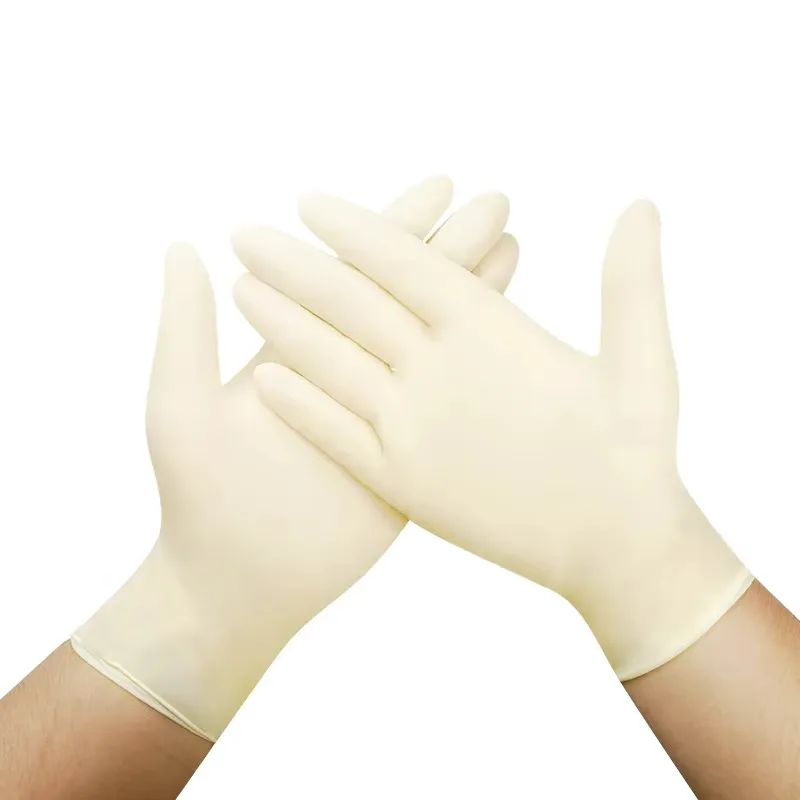Choosing the right gloves for lab work depends on your specific tasks, chemical exposure, and allergy concerns. Nitrile gloves offer superior chemical resistance and zero allergy risk, while latex gloves provide better comfort and flexibility for general laboratory tasks. However, with latex allergies affecting up to 12% of healthcare workers, how do you make the best choice for your laboratory environment?

Quick Comparison: Latex vs Nitrile Gloves for Lab Work
| Feature | Latex Gloves | Nitrile Gloves |
|---|---|---|
| Chemical Resistance | Limited | Excellent |
| Puncture Resistance | Good | Superior |
| Allergy Risk | 8-12% of healthcare workers | None |
| Cost | Lower | Higher |
| Comfort | Excellent fit | Good fit |
| Best For | General tasks, biological samples | Chemical work, allergic individuals |
| Market Growth | Declining | 10.6% CAGR through 2032 |
What Makes Nitrile Gloves Better for Chemical Work?
Nitrile gloves provide excellent chemical resistance against acids, bases, and organic solvents, making them the preferred choice for handling hazardous chemicals in laboratory settings. Additionally, these synthetic rubber gloves offer superior puncture resistance compared to latex alternatives.
Key Chemical Resistance Benefits:
- Superior protection against petroleum-based products
- Excellent resistance to acids and bases
- Strong barrier against organic solvents
- Better durability when handling sharp instruments
Furthermore, nitrile gloves are preferred over latex because of their chemical resistance, their tendency to visibly rip when punctured, and to prevent possible latex allergies. This visible tearing feature helps laboratory workers immediately identify compromised protection.
Table of Contents


Why Do Latex Allergies Matter in Lab Safety?
Latex allergies affect approximately 8-12% of healthcare workers, with symptoms ranging from skin irritation to severe respiratory reactions. Consequently, many laboratories are switching to nitrile alternatives to protect their staff.
Allergy Statistics and Impact:
- Latex allergy affects approximately 1 percent of the general population and 8-12 percent of healthcare workers
- The prevalence of latex glove allergy in study subjects was 9.1%, with irritant contact dermatitis being the most common manifestation observed in 68.6% of cases
- Among nurses, the rate of allergic symptoms rose from 31.5% to 33.3% during the pandemic
Common latex allergy symptoms include:
- Skin redness and itching
- Hives or rash
- Runny nose and sneezing
- Difficulty breathing (severe cases)
Which Glove Type Offers Better Durability for Lab Work?
Nitrile gloves demonstrate superior durability with enhanced puncture and tear resistance compared to latex gloves. As a result, they last longer during demanding laboratory procedures involving sharp instruments or abrasive materials.
Durability Comparison:
- Puncture resistance: Nitrile wins with 3x better performance
- Chemical breakdown: Latex degrades faster with chemical exposure
- Shelf life: Nitrile maintains integrity longer in storage
- Temperature resistance: Nitrile performs better in extreme conditions
Moreover, nitrile gloves have a slight edge due to their resistance to punctures and tears, making them suitable for tasks involving chemicals and sharp objects.

How Much Do Different Glove Types Cost for Lab Budgets?
Latex gloves typically cost 20-30% less than nitrile gloves, but the total cost of ownership often favors nitrile due to reduced replacement frequency and allergy-related issues. Therefore, smart laboratory managers consider long-term expenses rather than just initial purchase price.
Cost Analysis Factors:
- Initial cost: Latex is cheaper upfront
- Replacement frequency: Nitrile lasts longer
- Allergy accommodation costs: Latex may require alternatives
- Waste disposal: Both types have similar disposal costs
Budget-friendly tips:
- Buy in bulk for better pricing
- Choose appropriate thickness for your tasks
- Consider powder-free options to reduce contamination
- Evaluate total cost including replacement frequency
What Thickness Should You Choose for Different Lab Tasks?
Glove thickness ranges from 3-8 mils, with thicker gloves providing better protection but reduced dexterity. Specifically, most laboratory work requires 4-6 mil thickness for optimal balance of protection and functionality.
Thickness Guidelines:
- 3-4 mils: Light lab work, sample handling
- 5-6 mils: General chemistry, moderate chemical exposure
- 7-8 mils: Heavy chemical work, extended wear
Task-specific recommendations:
- Biological samples: 4-5 mils for adequate protection
- Acid handling: 6-8 mils for enhanced safety
- Microscopy work: 3-4 mils for better tactile sensitivity
- Equipment cleaning: 5-6 mils for durability
When Should You Replace Laboratory Gloves?
Replace gloves immediately after any chemical spill, visible damage, or after 2-4 hours of continuous wear. Additionally, always change gloves between different chemical procedures to prevent cross-contamination.
Replacement Indicators:
- Visible tears or punctures
- Chemical spills or splashes
- Color changes or swelling
- Loss of flexibility
- After handling infectious materials
Best practices for glove replacement:
- Check for damage before each use
- Set timer reminders for extended procedures
- Keep spare gloves readily available
- Train staff on proper inspection techniques

colorful latex gloves5
How Do You Properly Size Gloves for Laboratory Work?
Properly sized gloves should fit snugly without being too tight, allowing full finger movement while maintaining tactile sensitivity. Most importantly, ill-fitting gloves can compromise both safety and work efficiency.
Sizing Guidelines:
- Measure hand circumference at the widest part
- Consider glove material stretch (latex stretches more)
- Account for extended wear (hands may swell)
- Test dexterity with typical lab tasks
Common sizing mistakes to avoid:
- Choosing gloves too large (reduced grip)
- Selecting overly tight gloves (fatigue and tearing)
- Ignoring brand variations in sizing
- Not considering hand swelling during long procedures
What Are the Environmental Considerations for Lab Gloves?
Both latex and nitrile gloves create significant waste, but nitrile gloves often require special disposal due to chemical contamination. Therefore, laboratories must balance safety needs with environmental responsibility.
Environmental Impact:
- Latex: Biodegradable but may contain harmful chemicals
- Nitrile: Not biodegradable, requires proper disposal
- Recycling options: Limited for contaminated gloves
- Volume considerations: Labs use millions of gloves annually
Sustainable practices:
- Use appropriate thickness to minimize waste
- Implement proper segregation for disposal
- Consider reusable gloves for low-risk tasks
- Train staff on efficient glove usage

latex gloves5
Which Industries Prefer Nitrile Over Latex Gloves?
Healthcare, pharmaceuticals, and chemical industries increasingly prefer nitrile gloves due to allergy concerns and superior chemical resistance. In fact, the global disposable medical gloves market is projected to grow from USD 10.40 billion in 2024 to USD 33.42 billion by 2032, with nitrile leading this growth.
Industry Preferences:
- Healthcare: 70% nitrile adoption
- Pharmaceuticals: 85% nitrile preference
- Chemical laboratories: 90% nitrile usage
- Food processing: Mixed usage based on regulations
Market trends show:
- Nitrile gloves market expected to reach $11.31 billion by 2032 with a CAGR of 10.60%
- Increasing regulatory pressure for allergy-free workplaces
- Growing awareness of chemical resistance benefits
How Do You Test Glove Compatibility with Chemicals?
Always consult Safety Data Sheets (SDS) and perform compatibility testing before using gloves with new chemicals. Furthermore, many glove manufacturers provide detailed chemical compatibility charts for their products.
Testing Methods:
- Permeation testing: Measures chemical breakthrough time
- Degradation testing: Evaluates material changes
- Penetration testing: Checks for pinholes or defects
- Compatibility charts: Reference manufacturer data
Key testing considerations:
- Test actual working conditions (temperature, concentration)
- Consider mixture effects with multiple chemicals
- Evaluate degradation over time
- Document results for future reference
What Are the Latest Innovations in Laboratory Gloves?
Recent innovations include textured surfaces for better grip, extended cuff lengths for enhanced protection, and color-coding systems for different applications. Additionally, manufacturers are developing more comfortable formulations to reduce hand fatigue.
Current Innovations:
- Textured fingertips for improved grip
- Extended cuffs for wrist protection
- Color-coding systems for task identification
- Powder-free formulations to reduce contamination
- Antimicrobial treatments for extended wear
Future developments include:
- Smart gloves with chemical detection
- Biodegradable synthetic materials
- Enhanced puncture resistance
- Improved tactile sensitivity

colorful latex gloves3
Frequently Asked Questions
Can I wash and reuse disposable lab gloves?
No, disposable gloves are designed for single use only. Washing can compromise their integrity and create microscopic holes that allow chemical penetration. Always use fresh gloves for each task.
How long can I safely wear the same pair of gloves?
Replace gloves every 2-4 hours during continuous use, or immediately after chemical exposure. Extended wear can cause hand fatigue and reduce protective effectiveness.
Are powder-free gloves better for laboratory work?
Yes, powder-free gloves are generally preferred because they reduce contamination risks and allergen exposure. The powder can interfere with sensitive laboratory procedures.
What’s the difference between medical-grade and industrial-grade gloves?
Medical-grade gloves meet stricter quality standards for barrier protection and are tested for viral penetration. Industrial-grade gloves focus more on chemical resistance and durability.
Can I use latex gloves if I’m not allergic?
While you can use latex gloves if you’re not allergic, prolonged exposure can develop allergies over time. Many laboratories choose nitrile as a preventive measure.
How should I store laboratory gloves properly?
Store gloves in a cool, dry place away from direct sunlight and chemicals. Proper storage extends shelf life and maintains protective properties.

Conclusion: Choosing between latex and nitrile gloves for lab work requires careful consideration of your specific needs, budget, and safety requirements. While latex gloves offer superior comfort and lower cost, nitrile gloves provide better chemical resistance and eliminate allergy risks. Most modern laboratories are transitioning to nitrile gloves for their superior protection and growing affordability.
Remember that proper glove selection is just one part of laboratory safety. Always follow your institution’s safety protocols, receive proper training, and regularly review your protective equipment choices to ensure optimal protection for all laboratory personnel.
🔐 Privacy respected. No spam. Ever.
